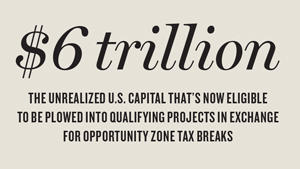
It may sound vague given its government-issued name, but the Opportunity Zone program is the new rock star of real estate. And there’s good reason why: It is very likely to generate a financial windfall for real estate investors from coast to coast.
The tax-break program — which was tucked into President Trump’s Tax Cuts and Jobs Act of 2017 — allows investors to skirt capital gains if they put their money into projects that sit in qualifying zones.
“The Opportunity Zone program could be the biggest thing to happen in real estate in my lifetime,” Bryan Woo, an executive at developer Youngwoo & Associates, recently told The Real Deal.
That reality seems very obvious to investors. RXR Realty, Normandy Real Estate Partners, Shorewood Real Estate Group, Somerset Partners, Youngwoo & Associates and EJF Capital — as well as investment platforms like Fundrise — are collectively racing to raise $2.7 billion to invest in New York City and elsewhere. And they are just a handful of the players raising capital.
An analysis by the Economic Innovation Group, the think tank that championed the program and was founded by Sean Parker of Napster fame, estimated that unrealized capital gains by U.S. households and U.S. corporations may amount to $6 trillion — all of which would now be eligible to be plowed into projects in one of the 8,700 designated census tracts across the country.
And property sales in opportunity zones are already skyrocketing.
Here’s a rundown on OZs.
What is an opportunity zone?
The program — which was originally proposed in 2016 as its own law — allows real estate players to defer capital gains when they invest capital into projects in qualified zones. Think of it like a 1031 exchange, in which a commercial property owner who sells a building can defer capital gains by buying another building within 180 days.

But in this case, investors can’t put their money directly into a property. Instead, they have to invest in an Opportunity Zone Fund. And that is why funds are popping up at such a feverish pace.
Once capital gains are made, investors have 180 days to put them in a fund.
The investor then has to spend at least the equivalent of the purchase price (exclusive of the value of the land) on upgrading the property.
Those who hold onto the investment for five years can then deduct 10 percent off their capital gains bill. That deduction jumps to 15 percent after seven years. If the investment is held for 10 years, any profit will be tax-free.
These tax breaks mean the potential for more profits for investors.
Mark Edelstein, chair of the real estate group at the law firm Morrison & Foerster, said that the cost of Opportunity Zone capital should be cheaper than capital from traditional sources.
“In theory, it should be less than the same project in exactly the same location without the tax benefit,” he said.
And that should mean investors will be willing to accept lower returns on their equity.
“It should be that the return is adjusted downward a bit because they get this enormous tax benefit,” he added.
Where are NYC’s opportunity zones?
In April, Gov. Andrew Cuomo’s Empire State Development submitted a list of 306 Opportunity Zones in the five boroughs, which were approved the by the U.S. Treasury Department and the Internal Revenue Service.

In order to qualify, a census tract has to have a poverty rate of at least 20 percent and a median family income no higher than 80 percent of that area’s median income. But there’s a catch: Census tract that don’t meet those requirements can also qualify — if they’re adjacent to a low-income tract.
In the five boroughs, where rich and poor often live side by side, many of the qualified zones are in desirable neighborhoods — that have already been significantly developed. For example: Hell’s Kitchen, Kips Bay, the Lower East Side, Long Island City, Astoria, the Brooklyn Navy Yard — in addition to dozens of others.
While New York City stats were not immediately available, in Los Angeles, more than 25 percent of upcoming residential units and nearly half of the commercial space already lie in Opportunity Zones, according to an analysis by The Real Deal of ground-up new construction filed with the Department of City Planning from October 2017 through September 2018.
Who stands to benefit — other than developers?
Developers aren’t the only ones poised to make money on OZs. Property owners, lawyers and brokers are also already seeing more business spurred on by the program.
Sales of development sites in OZs across the country increased 80 percent year over year in the first three quarters of 2018, according to data from Real Capital Analytics.
In the Bronx, investors bought $225.7 million worth of sites in zones in the first nine months of this year — up 840 percent from $24 million during the same period in 2017, according to the RCA data.
Avison Young’s James Nelson said he and his team are “laser-focused” on identifying potential Opportunity Zone sites, particularly in the farther reaches of the outer boroughs.
“Whenever we are valuing a site in the boroughs, the first question is, ‘Is it in an Opportunity Zone?’” he said.
How much time do investors have?
The short answer is: not much. Investors have until December 31, 2019, to purchase a property in a qualified zone if they want to land the full 10-year benefit. Given that it can take months to source and close a deal, the clock is already ticking.
That’s why so many real estate players are scrambling to launch funds and identify projects. That time pressure is compounded by the fact that the program favors properties that are shovel-ready. And the competition to get projects approved is likely to be heated.
But government officials have left investors with scant information.
The mayor of Los Angeles, Eric Garcetti, told the Wall Street Journal it was the “biggest initiative of this type by the federal government with the least debate, the least staff support, the least research and still the least clarity.”
After months of anticipation, late last month the Treasury finally released more explicit guidelines.
Those guidelines specified that regulators would treat cash as a qualified asset — something the industry was waiting for clarification on — as long as investors set out a plan of how it’s going to be deployed. In addition, Treasury officials told the Journal that projects will qualify if 70 percent of the property is located within a designated zone. And the new guidelines spell out that investors will have 180 days to defer the gains into a fund, which then has 31 months to invest —rather than the six months that initial provisions appeared to require.
But even those guidelines are not complete. A few weeks before the regulations were made public, Treasury officials acknowledged that they would have to release a second set of guidelines in response to all of the questions surrounding the program’s implementation. That outline is now expected before the end of the year. Many are waiting for that final clarity before deploying their capital, though.
Morrison & Foerster’s Edelstein agreed the clock is ticking.
“While it sounds like we have lots of time, we only have a year and a quarter,” he said. “There probably will be a rush of deals between now and the middle of next year to get that process started.”
Why are OZs controversial?
It wouldn’t be a federal program if it wasn’t mired in political controversy.
Already, opponents have raised concerns about whether the program will drive money into the areas that most need it — and whether it will lead to gentrification that could end up pushing out low-income residents.
In addition, critics also argue that the program may amount to a giant tax giveaway to developers who would already be making these investments.
Shorewood Real Estate Group, for example, bought a $20 million development site in Jamaica in August through its $250 million opportunity fund.
Shorewood CEO Lawrence Davis in September told Commercial Observer that the project was something the company “would have developed anyway,” explaining that the 300-unit apartment project pencils out without the tax benefit.
The political headwinds have led some to draw comparisons between OZs and the controversial EB-5 program, which gives foreign investors visas in exchange for economic investments in U.S. projects.
Among other things, critics of that program have argued that the program is backing projects in ultrawealthy areas rather than the low-income zones that need an economic jump-start.
The industry has already pushed back on recommendations that the government more closely vet OZ funds to ensure that they will actually create more affordable housing. The Real Estate Roundtable, the influential national trade organization, wrote to the Treasury and the IRS in June, saying that would create an unnecessary “bottleneck.”